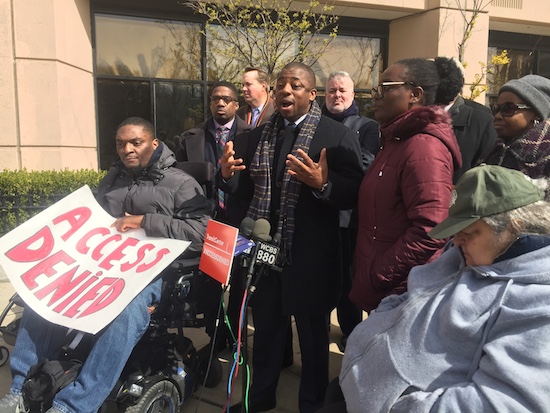
State Senator Brian Benjamin wants the MTA to make more stations accessible to people with disabilities.
By Carol Tannenhauser
“Accessibility” was the rallying cry of politicians, activists, and concerned citizens at a protest Monday morning at the subway station at 110th Street and Frederick Douglass Boulevard, which will be closed until the fall for renovations, as part of the “Enhanced Station Initiative” of the MTA’s $27-billion, five-year capital plan.
Outrage was the predominant emotion.
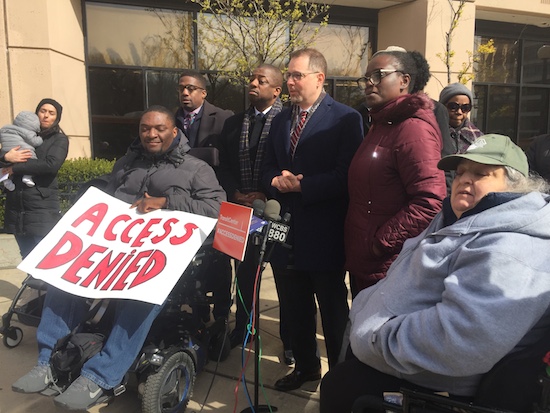
Councilman Mark Levine said there was “no improvement in access.”
“This kind of renovation is done once a generation — if we’re lucky — and we are blowing the opportunity to do it right,” said City Council Member Mark Levine, whose District 7 includes Morningside Heights, West Harlem, part of the Upper West Side, and Washington Heights. “There is no improvement in access in this station or the other three along the B-C line that are already closed or will be closed: 163rd, 86th, and 72nd Streets.
The 86th Street station will close on June 4th; the 72nd Street station, on May 7th.
“The intent and the letter of the Americans with Disabilities Act (ADA) is clear,” Levine continued. “If you are going to do major capital work, you must include accessibility as part of the plan. We’re not doing that at any of these four stations. We have a stretch from Columbus Circle to 125th Street — seven stations — where not one is accessible to a person in a wheelchair. We’ve been screaming about this since the plan was announced. We believe it’s a violation of the ADA, and we want a feasibility study about expanding accessibility up and down this line as soon as possible.”
It can’t be soon enough for Sasha Blair-Goldensohn, 41, who’s been in a wheelchair for nearly nine years. He made headlines in 2009, when, on his way to work as an engineer at Google, he was nearly killed by a falling branch in Central Park. “It was extraordinarily bad luck,” he said. It turned him from a “private citizen” into an “advocate.” Top of his list is getting someone in a wheelchair on the MTA Board.
“Who was planning this?” Blair-Goldensohn demanded. “Who was in that room making the decision? The MTA Board is appointed, largely, by Governor Cuomo, who is not getting diversity onto the Board in any way, including anybody with a visible disability. Until there’s somebody on that board who’s in the position we’re in all the time: not being able to get somewhere; having to make different plans; getting stuck in the station and getting carried up the stairs; until that happens, it’s not going to be top of the mind for them.
“There’s a lot of other things that they’re doing here,” he continued. “They’re putting in new tiles, UBS ports, all kinds of things we can use. But that’s not the priority. We’re not asking for a rocket to Jupiter or a submarine in the reservoir. We’re asking for an elevator! It’s so obvious and fundamental, and there are so many people who need it. It’s not just wheelchairs. It’s older people, parents with strollers, tourists with luggage, MTA workers; they’re all going to use it once it’s there.”
Blair-Goldensohn held a sign made by his 11-year-old daughter, Sophie. “Let Us Ride!” it proclaimed, with a picture of a dinosaur. “It has the dinosaur to symbolize that these stations are dinosaurs,” he said, “and, also, that the station right by the natural-history museum doesn’t have an elevator either.”
Another objection to the station closures concerned what State Senator Brian Benjamin described as the “atrocious” communication of the plans to the local community boards and the public.
“We should not be standing here, looking at a boarded-up train station, having these conversations, asking these questions,” Benjamin said. “This is what we have community boards for. If we had had community input and communication, at least three to six months in advance, we could have discussed all these issues. Instead, we’re having this plan shoved down our throats.”
Benjamin has introduced legislation requiring the MTA to give at least 90 days’ notice to the neighboring community boards of planned station closures in the future.
It is interesting to note, as reported in WSR, that CB7 rejected a call by State Assembly Member Linda Rosenthal in early March “for the MTA to delay the station upgrades so the community could speak out at a hearing.” Levine pointed out, however, that “there was almost no communication with CB10, which is Central Harlem, and very, very little with CB9, and that what was done was last minute and haphazard. Most people who are coming to this station this morning are learning about the closure because it’s boarded up.”
Shams Tarek, a spokesperson for the MTA responded to the criticisms, in an email:
“There is critical structural repair and functional improvement work being done here that when completed will benefit commuters for generations to come,” he wrote. “We are in contact with local elected officials and value our relationship with local communities. After weeks of advance notice and discussions, we’re now closely monitoring local subway and bus ridership and will make adjustments as necessary. New NYC Transit President Byford has made accessibility one of his top priorities from day one of his tenure, and MTA Chairman Lhota has convened a working group among members of the MTA Board to tackle the challenge of making more of the system accessible as quickly as possible.”



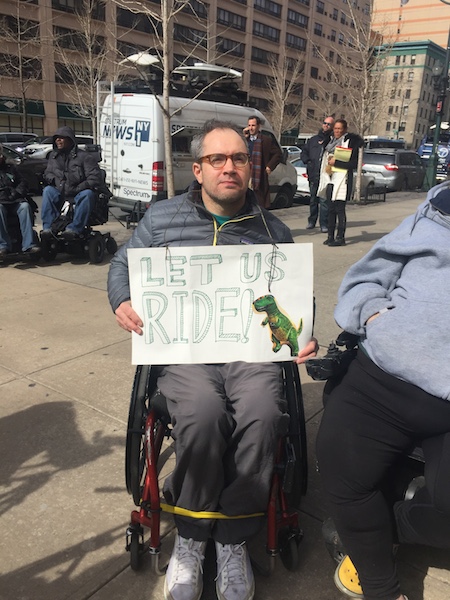




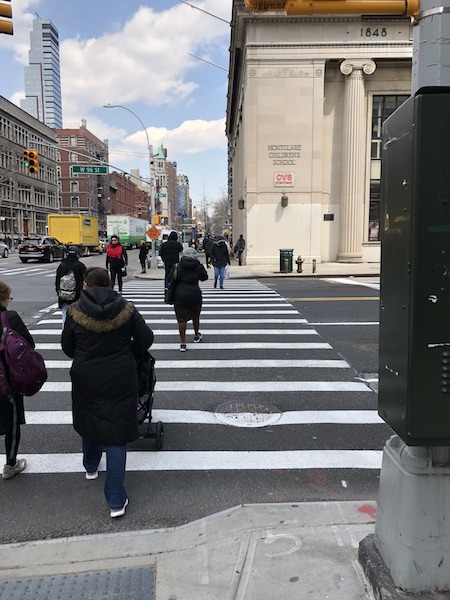
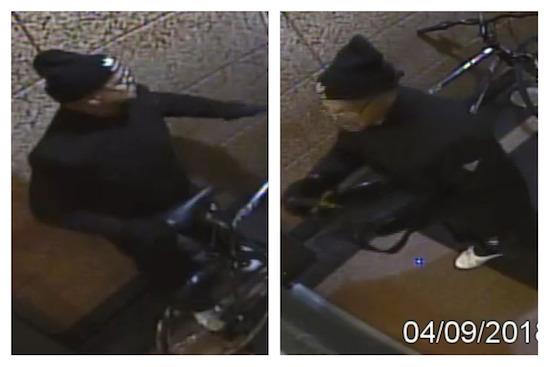
Shouldn’t CMs Rosenthal and Levine (as well as Assemblywoman Rosenthal) been aware of the plans for these stations well before the closings and current upgrades were announced? It’s crazy that there are no accessible stations between 59th & 125th Streets and it seems to me they should’ve been involved and fighting hard for this a long time ago.
If I went to my elevator contractor and wanted to install a one stop elevator, they’d give me a price of ~$100,000. Based on the prices the MTA paid for an elevator downtown recently, the price would be $10 million to $15 million. Since these stations would need multiple elevators, you’re talking about ~$50 million per station.
Fix the bloated, corrupt MTA and we’ll get our elevators and a whole lot more.
“Who was planning this?” Blair-Goldensohn demanded. “Who was in that room making the decision?
Good luck with that.
Like all decisions, the “Committee Agreed”.
No responsibility taken for anything.
It is shameful–and a clear violation of federal law–that these subway stations are being renovated without adding elevators. Anyone without mobility issues today could have them tomorrow. As Sasha Blair-Goldensohn rightly asks: who was in the room that made these decisions? We know who has primary responsibility for the MTA: the awful Andrew Cuomo.
How did AMNH get the MTA to bypass the 81st St station?
“Blown opportunity” conjures what could very well be an apt metaphor for the windfall that certain privileged players are enjoying here at taxpayer expense…
Name names.
Now unlike the AMNH expansion, this is a REAL tragedy.
Now, if all those people who claim the AMNH addition will be “catastrophic” could direct their efforts toward helping their neighbors, then maybe we could actually improve some peoples lives.
Those living with disabilities are not handicapped. Rather, it is us who act to handicap those living with disabilities.
This is shameful.
This should have been done in the 70″s when the Cathedral Towers were built. Since it wasn’t done then I hope it’s done now. If not shame on the M.T.A.
This project was poorly conceived and terribly executed. ESI was supposed to fund the renovation of 32 stations. It can now only cover the cost of 19 stations due to cost overruns.
https://ny.curbed.com/2018/4/3/17193678/mta-subway-enhanced-station-initiative-budget
Initial projected cost per station: $28 million
Revised projected cost per station: 43 million
More appalling, MTA President Joe Lhota chose to withhold this information from the MTA board when the project was under discussion.
I mean, we all knew that this was a glorified vanity project for Cuomo, who is under immense political pressure to show that he’s doing something, anything, to address the MTA’s horrific conditions.
But for the MTA president to withhold this budget information from the board underscores just how political, inept, and dysfunctional the MTA truly is. And no amount of “emergency funding” can fix that.
It’s very sad that no one has commented on this article, but that plenty have commented on articles about Trader Joe’s & the like. Don’t get me wrong, I adore Trader Joe’s, but the lack of interest in making our city accessible for those not fully able-bodied is a sign of where we are as a culture. We are, frankly, not interested in concerning ourselves with the needs of the movement-impaired…until or unless we become one of them. The MTA spokespeople who say that they’re working to make the system more accessible make me sick. A society is (or should be) judged by how it treats those most in need–not by how many countdown clocks it has, or by the quality of its wifi. To add insult to injury, the MTA has the audacity not to increase bus service along the affected routes. This means that people who can’t take the subways anyway because they have no elevators are currently relying on buses. Once the able-bodied flood the buses because the subways are closed, people in wheelchairs/with canes/with strollers/with injuries will be waiting doubly long to fit on. Those whose mobility impairments or injuries aren’t readily visible will continue to be denied seats on those buses as teenagers and adults who don’t need those seats take them anyway.
Yes, I understand that most people are not mobility impaired, and that there’s a way in which it might be logical for the needs of the majority to trump the needs of the minority. To that I say, wait and see how you feel if you become part of the minority. Do you think that someone paralyzed by a tree while walking through the park ever thought he’d become an activist for transportation accessibility? I’d put my money on ‘nope’. Any one of us could be him, and we might be him come tomorrow.
At present I am fairly able-bodied, save for a temporarily condition that’s made it painful to take the subway stairs. I’d happily campaign with the mobility impaired, because it’s the ethical thing to do. They are to be commended, not ignored. Don’t waste your typing to tell me that it’d be a huge expensive task to make the subways accessible. That huge expensive task should’ve been done decades ago. Instead the MTA tosses lights and mirrors to those who need them least, raising fares and ignoring those who are screwed by its lack of elevators on a daily basis. Those people should receive free unlimited cards every single month. If you’re an MTA spokesperson who lies about caring, you should be ashamed of yourself. If you’re an able-bodied citizen who pushes onto a bus before someone with a cane or a stroller, same.
MTA, tear up the sidewalks and make your system accessible, even if it takes years or puts less money in your pockets. When it comes to transportation, the needs of the few are simply more important than the perceived needs of the many. The few have waited long enough. The many can walk.
Your “Comments Welcome” Comment is filled. 9 of the 10 Comments now appearing above yours are VERY CONCERNED with helping the less-mobile (the one exception is #6 above, which I expect is just provocative).
IN am an able-bodied man, but not young. I helped a woman with a heavy cart full of tires up the hill this morning. So mentioned that her doorman was reluctant. Maybe we just help each other, and ignore the shirkers. They deserve just that.
Yes–I think WSR had a bit of a backlog in approving comments. When I submitted mine, there weren’t yet any comments on this article. I am encouraged and relieved to read of others’ interest in the matter of subway accessibility. These comments may not be as numerous as those on other articles, but I’m relieved there are at least SOME.
Yes, sorry we had a delay in moderating. Apologies!
WSR
The MTA doesn’t need a committee to figure out how to make stations accessible. That’s a smoke screen and a delaying tactic. Installing internet access and the rest of the bells and whistles is much more Fun that doing the work of making these stations and the system accessible. Sadly, the MTA doesn’t care about accessibility or customers. Look at its track record.
YES accessibility is the main thing to be fixed. Bells and whistles are nice but wheelchairs are a necessity not a luxury
Let us be a humane city and be known for that
MTA should put a higher priority on civil rights, because that’s what this is all about. Denial of equal access.
As soon as possible doesn’t sound soon enough. How more inconvenienced does someone in a wheel chair, on crutches,or any other issue have to be????